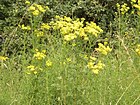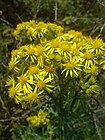Note: This is a project under development. The articles on this wiki are just being initiated and broadly incomplete. You can Help creating new pages.
Difference between revisions of "Jacobaea vulgaris - Ragwort"
(→Chemical Composition) |
|||
| (10 intermediate revisions by 2 users not shown) | |||
| Line 1: | Line 1: | ||
[[File:Senecio jacobaea - Le Sénécon jacobée - Jakobs-Greiskraut - Jacobskuiskruid - 3.JPG|thumb|right|''Ragwort'', ''Jacobaea vulgaris'']] | [[File:Senecio jacobaea - Le Sénécon jacobée - Jakobs-Greiskraut - Jacobskuiskruid - 3.JPG|thumb|right|''Ragwort'', ''Jacobaea vulgaris'']] | ||
| − | + | '''Jacobaea vulgaris''' is a very common wild flower in the family Asteraceae that is native to northern Eurasia, usually in dry, open places, and has also been widely distributed as a weed elsewhere. | |
| − | '''Jacobaea vulgaris''' | ||
| − | |||
| − | |||
| − | |||
==Uses== | ==Uses== | ||
| − | {{Uses| | + | {{Uses|Burns}}, {{Uses|Sores}}, {{Uses|Cancerous ulcers}}, {{Uses|Eye inflammation}}, {{Uses|Ulcerated mouths}}, {{Uses|Ulcerated throats}}, {{Uses|Internal bruises}}, {{Uses|Wounds}}, {{Uses|Dysmenorrhoea}} |
==Parts Used== | ==Parts Used== | ||
| − | {{Parts Used| | + | {{Parts Used|Roots}}, {{Parts Used|Flowers}}. |
==Chemical Composition== | ==Chemical Composition== | ||
| Line 38: | Line 34: | ||
==Identification== | ==Identification== | ||
===Leaf=== | ===Leaf=== | ||
| − | {{Leaf|Simple| | + | {{Leaf|Simple|Deeply lobed|The leaves of the basal rosette have petioles, cauline (stem) leaves are sessile and both are deeply lobed and alternate}}<ref name="Leaf"/> |
===Flower=== | ===Flower=== | ||
| Line 44: | Line 40: | ||
===Fruit=== | ===Fruit=== | ||
| − | {{Fruit| | + | {{Fruit|Simple|7–10 mm|Fruit are small and have a persistent ring of white hairs (pappus) attached||60,000-70,000}} |
===Other features=== | ===Other features=== | ||
| Line 59: | Line 55: | ||
==Commonly seen growing in areas== | ==Commonly seen growing in areas== | ||
| − | {{Commonly seen|Waste ground}}, {{Commonly seen| | + | {{Commonly seen|Waste ground}}, {{Commonly seen|Poorest soils}}. |
==Photo Gallery== | ==Photo Gallery== | ||
<gallery class="left" caption="" widths="140px" heights="140px"> | <gallery class="left" caption="" widths="140px" heights="140px"> | ||
| − | File: | + | File:Ragwort flowers.jpg |
| − | File: | + | File:Ragwort (14375659423).jpg |
| − | + | File:Common ragwort.JPG | |
| + | File:Ragwort scotland.JPG | ||
| + | File:Common Ragwort (Senecio jacobaea).jpg | ||
</gallery> | </gallery> | ||
| Line 71: | Line 69: | ||
<references> | <references> | ||
| − | <ref name="chemical composition">[https://www.researchgate.net/publication/269709096_Chemical_composition_of_the_essential_oil_of_Jacobaea_maritima_L_Pelser_Meijden_and_Jacobaea_maritima_subsp_bicolor_Willd_B_Nord_Greuter_Asteraceae_collected_wild_in_Croatia_and_Sicily_respectively | + | <ref name="chemical composition">[https://www.researchgate.net/publication/269709096_Chemical_composition_of_the_essential_oil_of_Jacobaea_maritima_L_Pelser_Meijden_and_Jacobaea_maritima_subsp_bicolor_Willd_B_Nord_Greuter_Asteraceae_collected_wild_in_Croatia_and_Sicily_respectively Chemical constituents]</ref> |
| − | <ref name="Leaf">[https://wiki.bugwood.org/Jacobaea_vulgaris | + | <ref name="Leaf">[https://wiki.bugwood.org/Jacobaea_vulgaris Plant description]</ref> |
| − | <ref name="How to plant/cultivate">[https://www.pfaf.org/user/Plant.aspx?LatinName=senecio+jacobaea | + | <ref name="How to plant/cultivate">[https://www.pfaf.org/user/Plant.aspx?LatinName=senecio+jacobaea Cultivation details]</ref> |
</references> | </references> | ||
| Line 85: | Line 83: | ||
[[Category:Herbs]] | [[Category:Herbs]] | ||
| + | [[Category:Ayurvedic herbs that don't have seed photos]] | ||
| + | [[Category:Asteraceae]] | ||
Latest revision as of 17:48, 22 May 2020
Jacobaea vulgaris is a very common wild flower in the family Asteraceae that is native to northern Eurasia, usually in dry, open places, and has also been widely distributed as a weed elsewhere.
Contents
- 1 Uses
- 2 Parts Used
- 3 Chemical Composition
- 4 Common names
- 5 Properties
- 6 Habit
- 7 Identification
- 8 List of Ayurvedic medicine in which the herb is used
- 9 Where to get the saplings
- 10 Mode of Propagation
- 11 How to plant/cultivate
- 12 Commonly seen growing in areas
- 13 Photo Gallery
- 14 References
- 15 External Links
Uses
Burns, Sores, Cancerous ulcers, Eye inflammation, Ulcerated mouths, Ulcerated throats, Internal bruises, Wounds, Dysmenorrhoea
Parts Used
Chemical Composition
Pentacosane (15.7%), heptacosane (13.1%) and nonacosane (8.1%) whereas the essential oil from J. maritima subsp. bicolor was characterised by the presence of hexadecanoic acid (14.6%), caryophyllene oxide (9.3%) and hexahydrofarnesylacetone (6.5%)[1]
Common names
| Language | Common name |
|---|---|
| Kannada | |
| Hindi | |
| Malayalam | |
| Tamil | |
| Telugu | |
| Marathi | NA |
| Gujarathi | NA |
| Punjabi | NA |
| Kashmiri | NA |
| Sanskrit | |
| English | Ragwort |
Properties
Reference: Dravya - Substance, Rasa - Taste, Guna - Qualities, Veerya - Potency, Vipaka - Post-digesion effect, Karma - Pharmacological activity, Prabhava - Therepeutics.
Dravya
Rasa
Guna
Veerya
Vipaka
Karma
Prabhava
Habit
Identification
Leaf
| Kind | Shape | Feature |
|---|---|---|
| Simple | Deeply lobed | The leaves of the basal rosette have petioles, cauline (stem) leaves are sessile and both are deeply lobed and alternate |
Flower
| Type | Size | Color and composition | Stamen | More information |
|---|---|---|---|---|
| Unisexual | 0.8 in. (2 cm) in diameter | Yellow | 5-20 | Flowering occurs in summer to early fall |
Fruit
| Type | Size | Mass | Appearance | Seeds | More information |
|---|---|---|---|---|---|
| Simple | 7–10 mm | Fruit are small and have a persistent ring of white hairs (pappus) attached | 60,000-70,000 | {{{6}}} |
Other features
List of Ayurvedic medicine in which the herb is used
- Vishatinduka Taila as root juice extract
Where to get the saplings
Mode of Propagation
How to plant/cultivate
Succeeding on all but the poorest soils, this plant is a declared noxious weed in Britain spreading freely by seed[3]
Commonly seen growing in areas
Photo Gallery
References
External Links
- Human Dermatitis After Skin Exposure to Jacobaea vulgaris and Spectrum of Health Hazards Induced by This Plant to Humans and Livestock
- Pyrrolizidine alkaloid variation in shoots and roots of segregating * hybrids Jacobaea vulgaris
- Jacobaea vulgaris on gobotany.newenglandwild.org
- Jacobaea vulgaris on nature gate plants
- Ayurvedic Herbs known to be helpful to treat Burns
- Ayurvedic Herbs known to be helpful to treat Sores
- Ayurvedic Herbs known to be helpful to treat Cancerous ulcers
- Ayurvedic Herbs known to be helpful to treat Eye inflammation
- Ayurvedic Herbs known to be helpful to treat Ulcerated mouths
- Ayurvedic Herbs known to be helpful to treat Ulcerated throats
- Ayurvedic Herbs known to be helpful to treat Internal bruises
- Ayurvedic Herbs known to be helpful to treat Wounds
- Ayurvedic Herbs known to be helpful to treat Dysmenorrhoea
- Herbs with Roots used in medicine
- Herbs with Flowers used in medicine
- Herbs with common name in English
- Habit - Perennial herb
- Index of Plants which can be propagated by Seeds
- Index of Plants which can be propagated by Cuttings
- Herbs that are commonly seen in the region of Waste ground
- Herbs that are commonly seen in the region of Poorest soils
- Herbs
- Ayurvedic herbs that don't have seed photos
- Asteraceae





